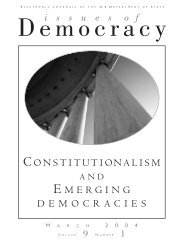Working for Women Worldwide - Embassy of the United States
Working for Women Worldwide - Embassy of the United States
Working for Women Worldwide - Embassy of the United States
You also want an ePaper? Increase the reach of your titles
YUMPU automatically turns print PDFs into web optimized ePapers that Google loves.
Success Story<br />
Microenterprise<br />
Lifting <strong>Women</strong> Out <strong>of</strong> Poverty<br />
Some <strong>of</strong> <strong>the</strong> biggest gains in <strong>the</strong> status <strong>of</strong><br />
women come from <strong>the</strong> smallest <strong>of</strong> projects.<br />
c Such is <strong>the</strong> case with microenterprises,<br />
generally defined as an in<strong>for</strong>mally organized<br />
business with 10 or fewer employees that<br />
zis owned and operated by someone who is poor.<br />
Throughout <strong>the</strong> developing world, U.S. support <strong>for</strong><br />
<strong>the</strong>se ventures has markedly improved <strong>the</strong> lives <strong>of</strong><br />
ordinary women, <strong>of</strong>ten lifting <strong>the</strong>m out <strong>of</strong> poverty.<br />
Take Fatouma Dijbril Issifou, who runs a vegetable<br />
stall in <strong>the</strong> town <strong>of</strong> Parakou in <strong>the</strong> West African<br />
nation <strong>of</strong> Benin. After receiving two loans totaling just<br />
$390, slightly more than Benin’s per capita gross<br />
national income, from a local nongovernmental organization<br />
(NGO), she was able to increase her pr<strong>of</strong>it<br />
margin by buying vegetables in bulk at a lower cost.<br />
Those pr<strong>of</strong>its have trans<strong>for</strong>med a previous hand-tomouth<br />
struggle <strong>for</strong> daily existence into a life that now<br />
enables her to buy sufficient food <strong>for</strong> her three children<br />
and pay <strong>for</strong> <strong>the</strong>ir education.<br />
In <strong>the</strong> Russian town <strong>of</strong> Otradniy, Tatyana Panova<br />
has used her two loans from <strong>the</strong> Foundation <strong>for</strong><br />
International Community Assistance to purchase <strong>the</strong><br />
foodstuffs necessary to expand her home-based business<br />
selling baked goods and full lunches to local cafes.<br />
Thanks to <strong>the</strong> pr<strong>of</strong>its earned through this thriving<br />
enterprise, Panova’s daughter is now able to attend<br />
technical college.<br />
And in Mexico, Baulia Parra Pruneda leveraged a<br />
microenterprise loan <strong>of</strong> $150, about 2.5 percent <strong>of</strong><br />
Mexico’s per capita gross national income, to purchase<br />
<strong>the</strong> supplies necessary to launch a sewing business.<br />
Through <strong>the</strong> proceeds she earns selling more than 100<br />
articles <strong>of</strong> clothing a week, she now is <strong>the</strong> breadwinner<br />
<strong>for</strong> her family <strong>of</strong> eight and has installed running water<br />
and a second floor in her home in <strong>the</strong> city <strong>of</strong><br />
Monterrey.<br />
Such success stories are a reason why, <strong>for</strong> <strong>the</strong> past<br />
three decades, <strong>the</strong> U.S. government, through its <strong>for</strong>eign<br />
assistance programs that support NGOs and<br />
host-country institutions, has placed a high priority on<br />
this brand <strong>of</strong> bottom-up development ef<strong>for</strong>ts encouraging<br />
entrepreneurship that help <strong>the</strong> poor—particularly<br />
poor women—help <strong>the</strong>mselves.<br />
In June 2003, Congress reaffirmed its commitment<br />
to microenterprise development by passing legislation<br />
that directed <strong>the</strong> U.S. Agency <strong>for</strong> International<br />
Development (USAID) to fund microenterprise<br />
activities at <strong>the</strong> level <strong>of</strong> $200 million <strong>for</strong> Fiscal Year<br />
2004. These activities benefit women in particular: In<br />
2003, women constituted two-thirds <strong>of</strong> loan clients <strong>of</strong><br />
USAID-supported micr<strong>of</strong>inance institutions.<br />
Reflecting on <strong>the</strong> growth <strong>of</strong> U.S. support <strong>for</strong><br />
microenterprise, Emmy Simmons, USAID’s assistant<br />
administrator <strong>for</strong> economic growth, agriculture, and<br />
trade, says: “Microenterprises account <strong>for</strong> a substantial<br />
share <strong>of</strong> total employment and gross domestic product,<br />
and <strong>the</strong>y contribute significantly to <strong>the</strong> alleviation <strong>of</strong><br />
poverty. They are <strong>of</strong>ten <strong>the</strong> chief economic defense <strong>of</strong><br />
<strong>the</strong> most vulnerable households. As <strong>the</strong> predominant<br />
source <strong>of</strong> income and employment <strong>for</strong> hundreds <strong>of</strong><br />
millions <strong>of</strong> people worldwide, <strong>the</strong> microenterprise sector’s<br />
influence on individuals, households, and national<br />
economies is clear and pr<strong>of</strong>ound.”<br />
<strong>Women</strong> are disproportionately represented in <strong>the</strong><br />
microenterprise sector. Across <strong>the</strong> developing world,<br />
<strong>the</strong> representation <strong>of</strong> women employed in <strong>the</strong> in<strong>for</strong>mal<br />
economy ranges from 58 percent in Latin America to<br />
84 percent in sub-Saharan Africa. Many <strong>of</strong> <strong>the</strong>se<br />
women do home-based work or street vending—<strong>the</strong>y<br />
34












